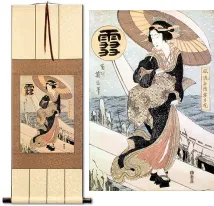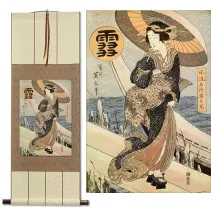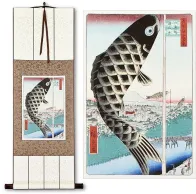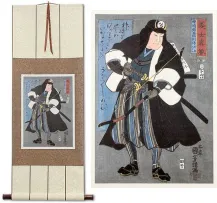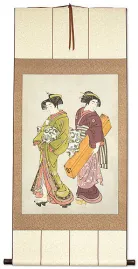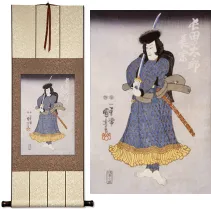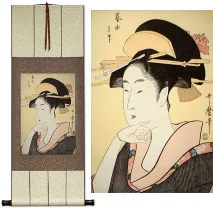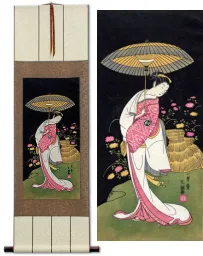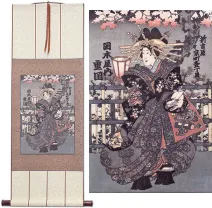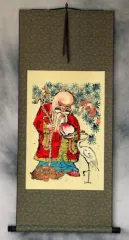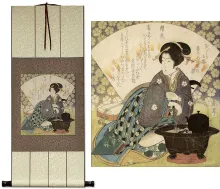Handmade Beauty In The Snow
Japanese Woodblock Print Repro Art Scroll
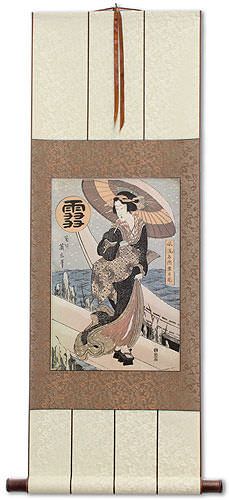

40¾"
18¼"
• Delivered to you in Columbus by Dec 31st.
• Standard shipping is just $3.80 for any order.
• Just 1 in stock now.
• Fine Art Giclée Print.
• Handmade Wall Scroll.
• Money-Back Guarantee.

This artwork will look great in your home or office.
Approximate Measurements
Artwork Panel: 28cm x 41.7cm ≈ 11" x 16½"
Silk/Brocade: 37.2cm x 103.8cm ≈ 14½" x 40¾"
Width at Wooden Knobs: 46.2cm ≈ 18¼"
Information about caring for your wall scrollSee Larger Image
Beauty with Umbrella in Snow
雪
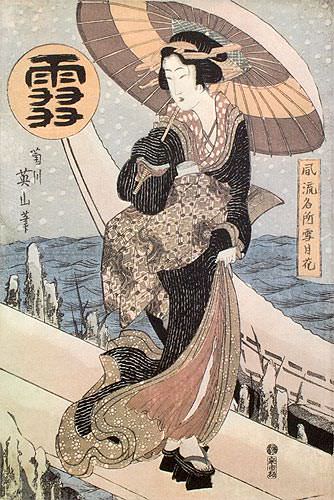
Close up view of the artwork mounted to this silk brocade wall scroll
This Japanese woodblock print reproduction features a Fukagawa Geisha strolling down the boat docks, carrying a parasol or umbrella to shield from the falling snow. On her feet, traditional black wooden clogs. The clothing and accessories indicate she is a Geisha of high stature or honor.
The original artist is 菊川英山 (Kikukawa Eizan). Born in 1787 and living to the rather old age of 80 (An impressive age at that time in history). He created woodblock prints until 1830 when he when on to pursue a career creating conventional paintings. However, he is one of the most revered woodblock artists, so it's almost a shame that he switched artforms.
The large character at the upper left is 雪 which simply means snow and is presumably Eizan's title for this piece.
Below that, you will see the artist's signature The artist's signature, 菊川 英山, followed by the character 筆 which indicates it was drawn by him (筆 literally means pen).
Additionally, there is an inscription that reads 風流各所雪月花.
風流各所 literally means wind, river, and various places. But 風流 together make a word that is understood to mean a refinement, elegance, or distinguished. So this actually refers to a high-class place.
雪月花 literally means snow, moon, and flowers. However, colloquially in Japanese, this refers to the beauty of the all the seasons or all of nature.
Original artist: Kikukawa Eizan 菊川英山 (1787–1867).
The original woodblock was carved/created in Japan, between 1800 and 1830. Although this image may be from a later printing.
About Real Japanese Woodblock Prints
Woodblock printing, often considered the precursor to the modern printing press, was first developed in China and later brought to Japan, where artists refined the technique into a unique art form. In Japan, these prints are called 木版畫 ("Moku Hanga"). Most were created during the Edo period (1603–1867), though production continued into the early 20th century.
Japanese artists would first create a "template painting" depicting scenes of daily life, including women washing clothes, men writing poetry, samurai battles, and occasionally more dramatic subjects. These template images, known as 浮世絵 (Ukiyo-e, or "Floating World"), were then carved into wood by skilled artisans. Another specialist applied wet ink or pigments to the carved blocks, and a sheet of handmade paper was pressed on to create the final print. This collaborative process produced vibrant, detailed artworks much faster than hand-painting hundreds of copies.
About This Reproduction
Original Japanese woodblock prints from the Edo period can sell for $800 to $20,000. Our prints are high-quality reproductions, crafted to capture the look and feel of the originals, though experts will recognize them as reproductions.
We use authentic handmade kozo (mulberry) paper—the same paper Japanese printmakers used centuries ago. Archival, UV-resistant pigment inks ensure long-lasting color, with laboratory testing showing up to 95 years of fade-free enjoyment if kept out of direct sunlight. Each reproduction is carefully color-corrected and restored, bringing the Edo period artwork to life for your wall.

Photographer Jeremy Cowart and the Canon imagePROGRAF PRO-2000 giclée printer used to create these reproductions.
Printing on delicate handmade paper is challenging. After testing multiple high-end printers, we found the Canon imagePROGRAF PRO-2000 delivers the precision and quality needed, using 12 archival inks and 18,432 nozzles. Each print is then sent to our Beijing workshop, where it is mounted into a handmade wall scroll, ready-to-hang without the need for expensive framing, giving your piece an authentic Japanese look.
Because the original artist has long passed, these works are public domain. In some cases, we license high-resolution scans of original prints, or even scan 200-year-old originals ourselves. This dedication ensures you receive a stunning Japanese woodblock print reproduction at an affordable price, making traditional Asian art accessible to everyone.
Want a custom wall scroll or unique print size? Just contact us!
We can print larger sizes, choose your preferred paper texture, and select silk brocade colors. Ready-to-frame prints can ship in days, while custom wall scrolls may take several weeks. Either way, the result is a truly one-of-a-kind piece of Japanese art.
This item was listed or modified
Feb 16th, 2020
